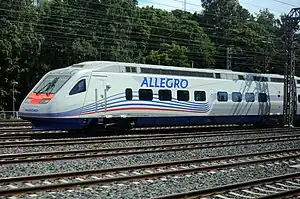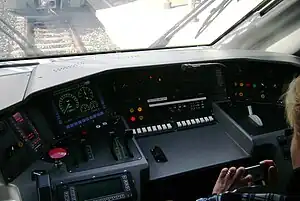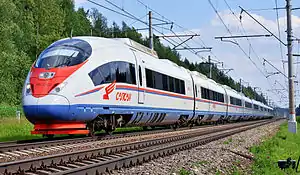| Allegro | |
|---|---|
 The train at Helsinki Central Station | |
| Overview | |
| Service type | High-speed rail |
| Status | Ceased operation |
| Locale | Russia–Finland |
| Predecessor | Sibelius and Repin |
| First service | 12 December 2010 |
| Last service | 27 March 2022 |
| Current operator(s) | Karelian Trains (joint venture between VR and RZD) |
| Route | |
| Termini | Helsinki Central Station, Helsinki, Finland Finland Station, Saint Petersburg, Russia |
| Stops | 8 |
| Distance travelled | 407 km (253 mi) |
| Average journey time | 3 h 27 min |
| Service frequency | 4 rounds daily (from 29 May 2011) |
| Line(s) used | Riihimäki–Saint Petersburg Helsinki–Riihimäki |
| On-board services | |
| Class(es) | Business and Economy |
| Seating arrangements | 341 seats |
| Technical | |
| Rolling stock | Karelian Trains Class Sm6 |
| Track gauge | Russian track: 1,520 mm (4 ft 11+27⁄32 in) Russian gauge Finnish track: 1,524 mm (5 ft) |
| Operating speed | 220 km/h |
| Track owner(s) | Russian Railways VR Group |
Allegro was the brand name of a now defunct high-speed train service, operated by Alstom VR Class Sm6 trains, between Helsinki, Finland, and St. Petersburg, Russia.
History
The service started on 12 December 2010.[1][2] The aim was to reduce travel time between Helsinki and Saint Petersburg: before Allegro, the journey time was 5½ hours; it became 3 hours and 27 minutes[3] over a journey of 407 km (253 mi) and there were plans to bring it down to 3 hours.[4] The name Allegro is a musical term for a quick tempo, thereby suggesting "high speed". On board the inaugural service were Finnish president Tarja Halonen and Russian prime minister Vladimir Putin.[5]
The service was suspended between 18 March 2020 and 11 December 2021 due to the COVID-19 pandemic.[6] Service resumed with restrictions on 12 December 2021.[7]
During the 2022 Russian financial crisis, in the aftermath of international sanctions placed on Russian companies following the 2022 Russian invasion of Ukraine, the Allegro train became a primary means for people to leave Russia.[8] As European airspace had been closed to Russian planes, and Russian airspace was closed to European planes, the train was the only passenger connection between Russia and the European Union. EU authorities asked VR to keep this train running so that those wishing to leave Russia could do so (though as part of COVID-19 restrictions, only Finnish and Russian citizens were allowed to use the train, and it ran only twice a day at half-capacity, of 327 passengers; but operators worked to lift those restrictions in order to allow the evacuation of other nationals).[9] The service was suspended on 27 March 2022 due to the aforementioned sanctions.[10]
In December 2023, it was announced that VR Group had assumed the financial obligations of the joint stock company that used to run Allegro since it could no longer meet them itself. VR Group plans to reuse the rolling stock in domestic operations.[11]
Route
Allegro connected the following stations:[12]
- St. Petersburg (Finlyandsky station)
- Vyborg
- Vainikkala
- Kouvola
- Lahti
- Tikkurila
- Helsinki (Central Station)
The trains also stopped previously in Pasila like every other passenger train from and to Helsinki, but this stop was discontinued between 27 March 2016 and 11 December 2021, when the stop in Pasila was revived.[13]
Vainikkala (on the Finnish side of the border) and Vyborg are special stations: on trains bound for Finland, passengers are not allowed to leave the train at Vyborg, as the train only stops to pick up passengers; and on trains bound for Russia, passengers are not allowed to leave the train at Vainikkala, for the same reason.
Border controls
On board the train, each passenger was visited by Finnish Border Guard and customs officers, as well as their Russian counterparts. Finnish border control took place while the train was travelling between Kouvola and Vainikkala, while Russian border control took place while the train was travelling between Vyborg and St Petersburg. If boarding/exiting at Vainikkala or Vyborg, the checks took place inside these stations.
Vehicles
| Karelian Trains Class Sm6 | |
|---|---|
 Driver's cabin | |
| In service | 2010–2022 |
| Manufacturer | Alstom |
| Built at | Savigliano |
| Family name | New Pendolino |
| Constructed | 2009–2011 |
| Entered service | 2010 |
| Refurbished | 2018–2019 |
| Number built | 4 |
| Number in service | 4 |
| Formation | 7 cars |
| Capacity | 337 + 2 disabled access + 38 in restaurant |
| Operators | VR Group, Russian Railways |
| Depots | Ilmala, St. Petersburg |
| Lines served | Helsinki – St. Petersburg |
| Specifications | |
| Train length | 184.80 m (606 ft 4 in) |
| Car length | 25.00 m (82 ft 0 in) 27.20 m (89 ft 3 in) |
| Width | 3,200 mm (10 ft 6 in) |
| Height | 4,270 mm (14 ft 0 in) |
| Floor height | 1,270 mm (4 ft 2 in) |
| Platform height | 200 mm (7.9 in) (Russia AC and Northern Finland) 550 mm (21.7 in) (Southern Finland) 1,100 mm (43.3 in) (Russia DC) |
| Doors | 12+12 |
| Maximum speed | 220 km/h (140 mph) |
| Power output | 5,500 kW (7,400 hp) |
| Electric system(s) | 25 kV 50 Hz AC 3 kV DC catenary |
| Current collector(s) | Pantograph |
| Safety system(s) | Finland: ATP-VR/RHK Russia: KLUB-U |
| Track gauge | Russian track: 1,520 mm (4 ft 11+27⁄32 in) Russian gauge Finnish track: 1,524 mm (5 ft) Wheelsets: 1,522 mm (59.92 in)[14] |
The Allegro service was operated using Class Sm6 trainsets built by Alstom. Sm6 stands for electric multiple unit (Finnish: sähkömoottorijuna, literally 'electric motor train') model 6.
The Sm6 appears externally similar to VR's earlier Sm3 Pendolino series, but is based on the fourth generation[15] 'Pendolino Nuovo' or 'New Pendolino' designs and its construction differs from the Sm3 in many ways.[14]
The top speed of the train in passenger traffic is 220 km/h (140 mph) which can be reached between Kerava and Lahti. The train can run at a speed of 200 km/h (120 mph) between Tikkurila and Luumäki and Vyborg and St. Petersburg after extensive rail works.[15] The aim was to reduce travel time between Helsinki and Saint Petersburg from 5½ hours to 3 hours.[4] The travel time as of 2017 was 3 hours 27 minutes.[3]
All four Sm6 trains were refurbished by VR FleetCare between 2018 and 2019.[16] The Sm6 fleet was primarily maintained at Ilmala depot north of Helsinki, although some maintenance mainly related to Russian technical systems was also performed in Saint Petersburg.
The Sm6 is equipped to operate on both the Finnish and the Russian railway networks. The units have dual-voltage electrical equipment able to use both the Finnish 25 kV 50 Hz alternating current and the Russian 3 kV direct current electrification systems. The wheelsets are built to run at over 200 km/h (120 mph) speeds on both the Finnish 1,524 mm (5 ft) and the nominally slightly narrower Russian 1,520 mm (4 ft 11+27⁄32 in) gauges, and the doors are equipped with a retractable step to make boarding from both Finnish 550 mm (21.7 in) high and Russian 1,100 mm (43.3 in) high platforms easy. The units are equipped for both the Finnish and Russian railway technical systems, which differ substantially.[17]
 First class coach (before refurbishment)
First class coach (before refurbishment) First class coach after refurbishment
First class coach after refurbishment Second class coach (before refurbishment)
Second class coach (before refurbishment)
On board services
- Food: there is a restaurant coach, which serves food during the whole journey, except during customs inspection.
- Currency exchange: there is an agent walking constantly back and forth on the train offering currency exchange services.
- Children's area: there is an area where small children can play.
 Restaurant coach (before refurbishment)
Restaurant coach (before refurbishment) Children's area (before refurbishment)
Children's area (before refurbishment)
See also
References
- ↑ "Allegro launch cuts Helsinki – St Petersburg journey times". Railway Gazette International. London. 13 December 2010.
- ↑ "Allegro". VR. Archived from the original on 11 May 2011. Retrieved 7 September 2010.
- 1 2 "Timetables". VR Group. Archived from the original on 30 November 2010. Retrieved 3 May 2011.
- 1 2 "News". Karelian Trains. Archived from the original on 28 March 2009. Retrieved 17 April 2010.
- ↑ "Putin joins Halonen on first run of high-speed Allegro train from Helsinki to St. Petersburg". Helsingin Sanomat International edition. Helsinki. December 2010. Archived from the original on 17 December 2010. Retrieved 17 December 2010.
- ↑ "Resiina - Artikkeli".
- ↑ "Few passengers as rail service between Finland and Russia resumes". 12 December 2021.
- ↑ Anderson, Christina (2 March 2022). "High-speed trains departing Russia for Finland are packed". The New York Times. ISSN 0362-4331. Retrieved 3 March 2022.
- ↑ Vanttinen, Pekka (3 March 2022). "St Petersburg-Helsinki train only direct link to Russia". www.euractiv.com. Retrieved 3 March 2022.
- ↑ "VR suspends train travel between Finland and Russia". Yle.fi. 25 March 2022.
- ↑ "Allegro trains to be deployed in VR's domestic long-distance traffic from 2025". vrgroup.fi. 14 December 2023.
- ↑ Timetables – VR Archived June 20, 2011, at the Wayback Machine
- ↑ "Allegro - VR".
- 1 2 "Allegro high speed Pendolino train presented at Finland station in Saint Petersburg". Alstom. 7 October 2010. Archived from the original on 7 July 2011. Retrieved 12 February 2011.
- 1 2 Salo, Sakari K (2011). "Helsingin–Pietarin liikenteen kehityksestä allegro". Resiina (in Finnish). Museorautatieyhdistys ry, Suomen Rautatiehistoriallinen Seura ry (1): 24–36. ISSN 0356-0600.
- ↑ "Nahkapenkit, uudet värit, ravintolaan sohvaryhmiä: Allegro-junat mukavuusremonttiin – ensimmäinen valmistuu MM-kisaturisteille". 19 April 2018.
- ↑ "2000-luvun tekniikalla kohti Pietaria" [Towards St. Petersburg with 21st century technology] (PDF). Rautatietekniikka (in Finnish). Rautatiealan Teknisten Liitto RTL ry. 22 (2): 10–12. 2010. ISSN 1237-1513. Archived from the original (PDF) on 17 July 2011.
